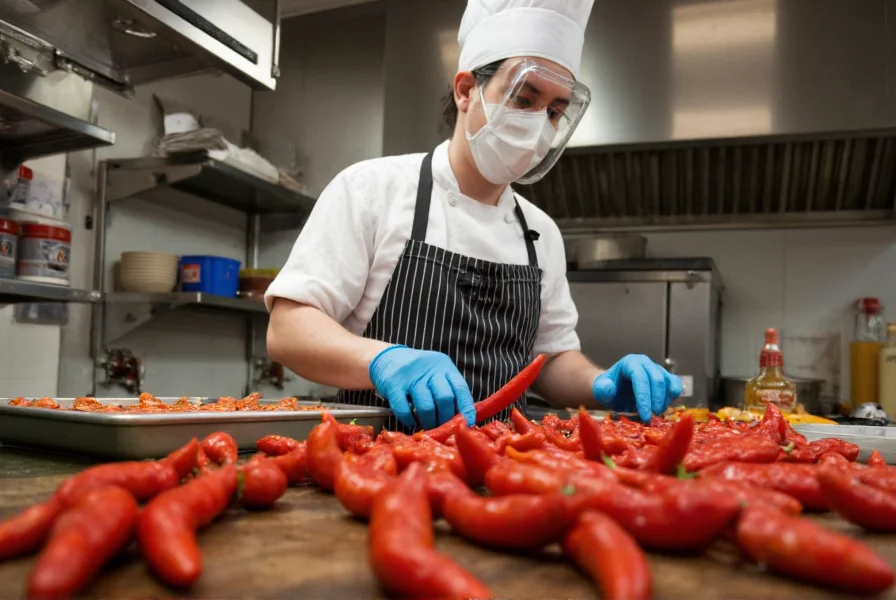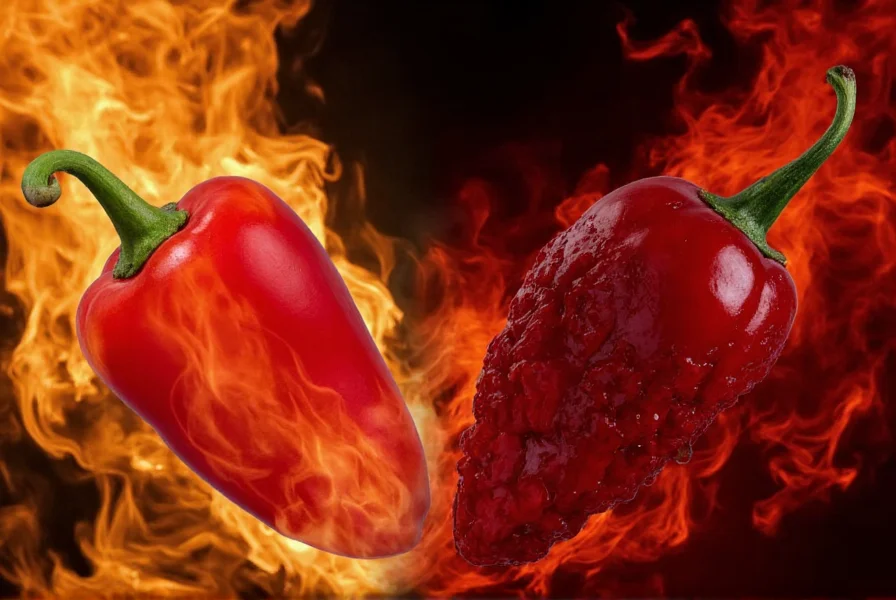The Carolina Reaper is significantly hotter than the Ghost Pepper, with an average Scoville Heat Unit (SHU) rating of 1,641,183 compared to the Ghost Pepper's 800,000-1,041,427 SHU. While both belong to the world's hottest peppers category, the Carolina Reaper holds the official Guinness World Record as the hottest chili pepper, delivering nearly double the heat intensity of the Ghost Pepper.
When comparing ghost pepper vs california reaper, understanding their heat levels is crucial for culinary applications and safety. These two super-hot peppers dominate the upper echelons of the Scoville scale, but their differences extend far beyond mere heat measurement. This comprehensive comparison examines their origins, heat profiles, flavor characteristics, and practical uses to help you determine which pepper best suits your needs.
Origins and Development Timeline
The historical progression of these peppers reveals critical milestones verified by authoritative institutions:
- Pre-2000: Ghost Pepper (Bhut Jolokia) cultivated in Northeast India with no global recognition
- 2006: Submitted for testing by New Mexico State University's Chile Pepper Institute
- 2007: Certified as world's hottest (1,001,304 SHU) by Guinness World Records
- 2011: Ed Currie crossbreeds Ghost Pepper with St. Vincent Red Habanero
- 2013: Carolina Reaper certified record holder (1,569,300 SHU average)
- 2017 & 2021: Re-tested and confirmed by Guinness World Records with updated average of 1,641,183 SHU
Source: New Mexico State University Chile Pepper Institute and Guinness World Records verification data

Heat Level Comparison
Understanding the heat difference between these peppers is essential for safe handling and culinary use:
| Pepper Variety | Scoville Heat Units (SHU) | Guinness World Record Status | Heat Relative to Jalapeño |
|---|---|---|---|
| Ghost Pepper (Bhut Jolokia) | 800,000-1,041,427 SHU | Former record holder (2007-2011) | 80-100x hotter |
| Carolina Reaper | 1,400,000-2,200,000+ SHU | Current record holder (2013-present) | 140-220x hotter |
The Carolina Reaper's heat isn't just stronger—it delivers a different heat experience. While the Ghost Pepper produces an immediate, intense burn that peaks quickly, the Carolina Reaper features a delayed onset (15-30 seconds) followed by an escalating burn that can last up to 45 minutes. This "creeping" heat pattern makes the Reaper particularly challenging for inexperienced users.
Physical Characteristics
Visual identification helps distinguish these peppers in markets or gardens:
- Ghost Pepper: Typically measures 2.4-3.3 inches long with a distinctive bumpy, wrinkled texture and a pointed tail. Colors range from red to orange, yellow, chocolate, and even white varieties.
- Carolina Reaper: Slightly larger at 1-2 inches wide and 2-3 inches long, featuring a characteristic "stinger" or small point at the bottom. The surface shows deep grooves and wrinkles, usually appearing in bright red when mature.
Flavor Profiles Beyond Heat
Despite their extreme heat, both peppers offer complex flavor notes that culinary enthusiasts appreciate:
The Ghost Pepper presents initial sweet, fruity notes reminiscent of apples or raisins, followed by smoky undertones before the intense heat hits. This flavor complexity makes it popular for hot sauces where the pepper's character shines through.
Carolina Reaper delivers a more pronounced fruity flavor profile with distinct notes of cinnamon and cherry, followed by its signature intense heat. Many hot sauce makers prefer the Reaper for its more complex flavor foundation that balances the extreme heat.
Culinary Applications
When considering ghost pepper vs california reaper for cooking, understanding their culinary applications is essential:
Chefs typically use Ghost Peppers in applications where moderate heat with distinctive flavor is desired. Common uses include:
- Traditional Northeast Indian cuisine
- Hot sauces with balanced heat profiles
- Marinades for meats
- Specialty pickles and chutneys
The Carolina Reaper's extreme heat requires more careful handling but offers unique applications:
- Competitive eating challenges
- Extreme hot sauces (often diluted with other ingredients)
- Pepper extracts and concentrates
- Specialty dishes where minimal quantity delivers maximum heat
Contextual Boundaries: Usage Limitations and Critical Constraints
Authoritative research identifies specific scenarios where each pepper's application becomes unsafe or ineffective:
Ghost Pepper Constraints
- Contraindicated for individuals with irritable bowel syndrome (IBS) due to capsaicin-induced symptom exacerbation (American College of Gastroenterology)
- Heat degrades significantly after 30+ minutes of cooking, making it unsuitable for slow-cooked dishes requiring sustained heat
Carolina Reaper Constraints
- Associated with reversible cerebral vasoconstriction syndrome (RCVS) in cardiovascular patients (NIH National Library of Medicine)
- Prohibited in home canning operations due to unpredictable heat concentration risking unsafe preservation (National Center for Home Food Preservation)

Growing Requirements
For gardeners interested in cultivating these super-hots, their growing requirements differ slightly:
Ghost Peppers thrive in hot, humid climates similar to their native Northeast India. They typically mature in 90-120 days and produce abundant yields under proper conditions. The plants grow to about 3-4 feet tall and require consistent watering.
Carolina Reapers need similar warm conditions but are slightly more challenging to grow. They require 90-100 days to mature but often produce fewer fruits per plant compared to Ghost Peppers. The plants grow to 2-4 feet tall and benefit from well-draining soil with consistent moisture.
Safety Considerations
Working with either pepper requires proper safety precautions, but the Carolina Reaper demands extra vigilance:
- Always wear nitrile gloves when handling
- Avoid touching face or eyes during preparation
- Work in well-ventilated areas (heat compounds can become airborne)
- Use separate cutting boards and utensils
- Start with minuscule quantities when cooking (1/16 teaspoon of powder can be sufficient)
The Carolina Reaper's extreme heat has been associated with "thunderclap headaches" and other adverse reactions in sensitive individuals. Medical professionals recommend having dairy products (milk, yogurt) readily available to counteract the burn, as water merely spreads the capsaicin oils.
Which Pepper Should You Choose?
Your selection between ghost pepper vs california reaper depends on your specific needs:
Choose Ghost Pepper if:
- You want intense but manageable heat
- You're new to super-hot peppers
- You prefer a more immediate heat response
- You need higher yields for gardening
- You want traditional pepper flavor with significant heat
Choose Carolina Reaper if:
- You seek the absolute maximum heat possible
- You're experienced with super-hot peppers
- You want complex fruity notes beneath the heat
- You're making extracts or extremely potent sauces
- You're participating in heat challenges
Availability and Sourcing
Finding authentic specimens requires attention to detail:
Ghost Peppers have become relatively common in specialty grocery stores, particularly in regions with significant South Asian populations. Dried Ghost Peppers, powders, and sauces are widely available from reputable hot sauce producers.
Carolina Reapers, while increasingly available, still require more careful sourcing. Look for products from certified growers who can verify the pepper's authenticity. Many "Reaper" products on the market actually contain less potent substitutes, so checking for third-party heat verification is recommended when purchasing.
Frequently Asked Questions
Which is hotter, ghost pepper or Carolina Reaper?
The Carolina Reaper is significantly hotter than the Ghost Pepper. The Ghost Pepper ranges from 800,000 to 1,041,427 Scoville Heat Units (SHU), while the Carolina Reaper averages around 1,641,183 SHU with some specimens exceeding 2,200,000 SHU. This makes the Carolina Reaper approximately twice as hot as the Ghost Pepper.
Can you substitute Ghost Pepper for Carolina Reaper in recipes?
Substituting between these peppers requires extreme caution due to the significant heat difference. If substituting Ghost Pepper for Carolina Reaper, you'll need approximately twice the amount to achieve similar heat levels. Conversely, when substituting Carolina Reaper for Ghost Pepper, use only half the quantity. Always add incrementally and taste carefully, as the heat difference can dramatically alter the final product.
Why does the Carolina Reaper have a delayed heat effect compared to the Ghost Pepper?
The Carolina Reaper contains different capsaicinoid compounds in varying concentrations compared to the Ghost Pepper. Specifically, it has higher levels of capsaicin and dihydrocapsaicin, which create a delayed but longer-lasting burn sensation. This 'creeping' heat effect typically begins 15-30 seconds after consumption and can last up to 45 minutes, whereas Ghost Pepper heat peaks more quickly but subsides sooner.
Are there any health risks associated with consuming Carolina Reaper peppers?
Consuming Carolina Reaper peppers carries potential health risks, especially for inexperienced users. Documented effects include severe gastrointestinal distress, 'thunderclap headaches,' and in rare cases, temporary blood vessel constriction. Individuals with heart conditions, gastrointestinal issues, or sensitivity to capsaicin should avoid these peppers. Always consume in minute quantities, have dairy products available to counteract the burn, and never force consumption beyond personal tolerance levels.
How can I verify if I'm getting authentic Carolina Reaper peppers?
To verify authentic Carolina Reaper peppers, look for certification from reputable growers, check for the distinctive 'stinger' or small point at the bottom of the pepper, and confirm through third-party Scoville testing if possible. Many commercial products labeled as Carolina Reaper may actually contain less potent substitutes. Reputable hot sauce producers often publish heat verification data for their products, which provides the most reliable confirmation of authenticity.











 浙公网安备
33010002000092号
浙公网安备
33010002000092号 浙B2-20120091-4
浙B2-20120091-4